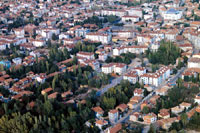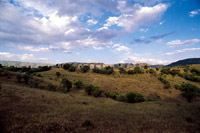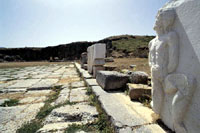Yalvaç
 Being the center of Faith Tourism, Yalvaç reflects the cultural wealth of Anatolia with its whole beauty. Founded by the Alexander the Great's General Seleukos, Yalvaç hosts to the very first and the biggest town of Pisidia; Antiocheia.
Being the center of Faith Tourism, Yalvaç reflects the cultural wealth of Anatolia with its whole beauty. Founded by the Alexander the Great's General Seleukos, Yalvaç hosts to the very first and the biggest town of Pisidia; Antiocheia.
 Climate
Climate
The climate carries the distinction of being caught between the Mediterranean climate and a continental climate. The highest temperature is 37 degree and the lowest is 18 degree.
History
Yalvaç, the ancient city of Antiocheia, is an important place for Anatolian Faith Tourism and consequently on the world map.The ancient city, Antiocheia, played an important role in the birth of Christianity and its spread throughout Anatolia and the world.
 Starting in the 2nd millenium BC, Anatolia witnessed the rise of Assyrian, Hittite, Lydian and Persian civilizations and from the time of the conquests of Alexander the Great up until the present day, this land has seen a number of new civilizations arise. The city of Antiochia was founded by one of Alexander the Great's generals, Seleucus I or his son Antiochos in the south of the Sultan Mountains at the site of a Psidian city. Put under the administration of the Celtic king, Amyntas, between 39-36 BC, it was later made a part of the province of Galatia. During the Roman period its name was changed to Colonia Caesarea.
Starting in the 2nd millenium BC, Anatolia witnessed the rise of Assyrian, Hittite, Lydian and Persian civilizations and from the time of the conquests of Alexander the Great up until the present day, this land has seen a number of new civilizations arise. The city of Antiochia was founded by one of Alexander the Great's generals, Seleucus I or his son Antiochos in the south of the Sultan Mountains at the site of a Psidian city. Put under the administration of the Celtic king, Amyntas, between 39-36 BC, it was later made a part of the province of Galatia. During the Roman period its name was changed to Colonia Caesarea.
From the end of the 3rd century AD, Antiocheia became the head of the province of Psidia. Coins recovered from the excavations conducted here reflect the wealth and productivity of this period. The coins are usually adorned by the Moon god, Men.
The city's golden era comes to an end with the beginning of the Arab invasions in 713 AD. During the second half of the 13th century, most of the residents leave this splendid historical city. Because the first Turkish tribe to settle in this area during the Selçuk Period was the Oğuz tribe called Yalvaç, the name of this ancient city has been called Yalvaç ever since.
With the disinegration of the ruling Selçuk Empire, which had taken over much of Anatolia, in the 1300's, a number of smaller kingdoms were established and Yalvaç came under the control of the Hamitoğlu dynasty, which gave great importance to Yalvaç and consequently there was quite a lot of development during this time. The Ottomans made Yalvaç a part of their own domain in the 1400's. The importance given to art by the Ottomans is reflected in the architectural structures which can be seen here. With the formation of the Republic, Yalvaç became a part of the province of Isparta.